Posted in Liner Notes, What's New
‘FIVE FATHOM RIP’
NOTES ON THE PROGRAMS:
‘Five Fathom Rip’
Recorded at: HT Recording Studio, Dennis, Cape Cod
Play’s locations: Sandwich Marina on the Cape Cod Canal and
Little Georges fishing grounds east of Cape Cod.
First broadcast: ?
Trivia: ‘Five Fathom Rip’ is a memorable show for lots of reasons: It marked the first appearance of Stephen Russell in a production; it is based on the real-life skipper, Bobby Kohl, and the making of it involved a harrowing night at sea in a gale and a near drowning incident.
Cast in order: Announcer . . . . . . . . . . . . . . George McConville
Bobby Winslow . . . . . . . . . . . Stephen Russell *
Hibbert . . . . . . . . . . . . . . . . . . Bob Gianferante
Granger . . . . . . . . . . . . . . . . . Bill Dame
Holloway . . . . . . . . . . . . . . . . Art Devine *
(*) First appearance in a CCRMT program
Author’s Notes and Recollections:
Sometimes it is hard to remember exactly where story ideas originate. However, with ‘Five Fathom Rip’ it’s easy. It’s two primary sources were the writings of Jack London and a crime story ripped from the daily headlines. At the time I had been going through a Jack London phase, not only his arctic tales but his sea adventures, particularly The Sea Wolf. I thought it might be fun to try something in his style for radio, that is: a suspense story set at sea, not fully dramatized like the standard radio play but narrated in the first-person, story-telling fashion. (For an excellent example of London’s style and how it is suited to radio, check out the fog-bound opening chapter of The Sea Wolf, note too his almost radio-like reliance on sounds as the ferryboat sinks.)
As fans of Radio Mystery Theater realize First-Person Narrative comes closest to approximating the ‘theater-of-the-mind’ aspect of radio that it is so known for. The dramatized play allows the listener to function as a fly on the wall overhearing what others say, but the First-Person style penetrates the wall of personality and allows the listener direct access to the thoughts of the story-teller, engaging the listener on a more intimate level to create a more involving experience.
The recipe, therefore, was going to be: To come up with a suspense story a Jack-London-style hero could tell and accompany his narration with a continuous stream of sound beds and discrete sound effects that would re-enact some of the action. Those, plus Mark Birmingham’s music to add punch and that was going to be the scheme for this thriller-at-sea.
First-Person Narrative approach is also a good choice when you’ve got a lot of ground to cover in your story and, as it turns out, I did. The inspiration was plucked from the headlines of a daily paper –only they were headlines I never read because I wasn’t in Florida. Instead through my high school high grapevine, specifically Skip Eckert and Mark Lloyd, I found out the shocking news that one of our fellow classmates at Manchester public school in Ohio, a student I had not known except by first name and to say hello to in the halls, had met with a gruesome end, knifed to death in his sleep onboard a shrimp boat off the coast of Florida. I never found out any more details abot what happened, except that apparently everyone else onboard was murdered too, everyone except the killer I presume. There was my plot-line all laid out like the keel of a ship and to which attaching the ribs of the story was a cinch. All I had to do was imagine gruesome ways in which crew members could be bumped off onboard a trawler. In an hour or two I had the basic outline all sketched out. Next, to write the script, all I had to do was learn everything there was to know about commercial fishing and then find someway to get to sea to record the raw sound effects that the production would require.
SKIPPER BOBBY KOHL
I inquired of Laine Davis (she of ‘Tanya Macklin’ of the ‘Caller on Line One’, who was giving the daily commercial fishing report over the radio and who was the darling with the entire fishing community) who I should consult and she gave me the name of a skipper whom she assured me would be my perfect resource. Boy was she right. Not only did Captain Bobby Kohl, answer all my questions and provide me the means to get to sea to record my sound effects, but he also turned out to be the perfect role model for my hero.
If you would seek to know more about the real person behind the fictional skipper of ‘Five Fathom Rip’ you don’t have to seek much beyond the story itself. Like the character of Bobby Winslow, Skipper Kohl was a hard-working fisherman born with a feisty streak of independence; he was co-owner of an dragger named Smuggler, and he really did have some frictional run-ins with the Coast Guard over the naming of his boat, for which he did contemplate substituting the Inuit word, Ooski, a minor Eskimo vulgarity (but then what commercial fisherman isn’t familiar with vulgarity, isn’t that why they call them the Vulgar Boatmen?).
Recall also in ‘Rip’ the tale that Bobby Winslow tells of having an enormous Basking Shark blunder into his net. Too large to fit on deck, he tells of his frantic efforts to cut the net into a sling and hoist the animal back in the water before it dies, that is a true Bobby Kohl story. Skipper Kohl is the kind of likeable guy who is well-liked and admired by everyone, including the Coast Guard, (note in the sweatshirt he’s wearing in the photo of the newspaper clipping. Asked about it he said, “It never hurts to advertise,” He is also the kind of ship captain you wouldn’t mind turning your life over too if you happen to be caught out at sea during a serious ocean gale.
THE NO-NAME STORM
If you examine the coastal weather records of New England from 1989 to 1991 you will note that there were three impressive ocean gales that occurred on three successive Halloweens in a row. The first was the Halloween Gale of 1989 also referred to as the No-name Storm. The second was the Halloween Gale of 1990, also referred to the No-name Storm (it doesn’t make sense that two storms should have the same name, although perhaps, since their names are ‘No-Name’ perhaps it does). The third big blow was in 1991 and that was the so-called, Perfect Storm, the one written about by Sebastian Junger in his book of the same name (I mean title).
From early on Bobby had invited me to tag along on a fishing expedition, and we did, the two of us, take Smuggler out and drag for muscles he was selling to the French. The real trip came when he invited me to join the crew on another vessel whose owner had asked Bobby to captain a trip. The vessel was twice as large as Smuggler and therefore able to venture out beyond the hook into George’s Bank.
The Rams was a long-in-the-tooth, Western rig fishing trawler. There was rot in her beams although she was still solid and the hull wasn’t leaking, but the superstructure was all made of two-by-four and marine plywood. that was basically the wrong kind of boat in the wrong kind of water. Instead of a deep-water keel that would have been much better suited for the cold temperature of New England ocean waters, the Rams was a flat-bottomed boat that should have been fishing a different Gulf altogether: the Gulf of Mexico not the Gulf of Maine. With its flat bottom it didn’t roll with the waves nearly as well like a deep-keeled boat would.
We would be out eleven days. The fishermen I sailed with were all initially gruff and stand-offish when I first came aboard and Bobby introduced me. However, their attitude quickly changed when they were informed I would not be in for a share of the trip money. Then one night after dinner in the galley these big, gruff, brave fishermen listened to and were all scared by ‘The Caller on Line One’ and that won them over.
The second night out the gale struck. There was some slashing rain involved, but mostly it was a wind event and seas event. I tried riding the front part of the storm out below decks in my bunk, not tossing in my sleep but being tossed. In an endlessly repeated sequence first came the fall as you slid down the face of a wave, followed by the extra force of gravity pressing you down in your bunk as you reached the bottom of the trough, then came the rapid uplift from the next wave and the weightlessness you experienced as you were tossed off its crest like off the lip of a ski jump. Repeat ad infinitum. My bunk had sideboards like a coffin against which I tried to brace myself, but after several hours of tobogganing like this, with the intensity of the storm only increasing not decreasing, I figured I may as well get up and face my doom with my shoes on. Having no prior experience, I couldn’t tell how bad our situation was and knowing of my tendency as a mystery writer to be overly dramatic, I hoped I was only being so now. However, climbing down from my bunk, I noticed the fisherman below me in his bunk was not asleep but wide awake, aiming his pen flashlight on a wallet-sized photo of his wife and kids which he clutched and stared at with with a fixed ferocity .
Up to now I had experienced no trace of sea-sickness, but as soon as I was up and staggering about the cabin, I was quickly seized by a surge of nausea that sent me scrambling outside for the deck and the rail. The over-head spreader lights were illuminated, throwing everything in stark relief and I could see the huge rollers coming out of the darkness and rolling under us or partially over us. I never made it to the railing before my dinner took flight. It didn’t matter anyway, the next thigh deep wave that broke over the railing received my jettisoned dinner and carried it over the opposite railing and out to sea with no mess and no clean-up required whatsoever.
Climbing to the wheelhouse, I found Bobby at the wheel, calm and concentrating on his steering to keep a careful angle to the waves. We were trying as best we could to make headway for the backside off the Provincetown Hook. He asked me, smilingly, if I was getting all the sound effects I needed. He then ruefully informed me that we had another problem besides the weather and the size of the waves. He nodded where I should look out, and I gazed back down from the wheel house at the spot where I had been and now saw that three fishermen in rain slickers had appeared carrying a hammer, nails and an armful of boards. Bobby explained the hull had sprung a leak and they were going to try to repair it from the outside while underway. In the accompanying photos if you look closely you will note there are two men are standing and leaning on the railing while the third is on his stomach, halfway out the scupper. Their method of repair: The men at the rails would hold onto the legs of the man on his stomach and hand him nails and boards over the side while the man on his stomach would time his hammering to the roll of the ship. When the hull plunged under, he would hold his breath; when the hull rolled up, he would hammer away furiously.
Eventually the leak was fixed and we were able to reach shelter in the lee behind the hook of Provincetown. In the aftermath the next morning, the storm had cleared out and the weather was splendid. The ship and all aboard had survived although there was some injury and some damage: One fisherman had involuntarily acted like a mountain goat and heaved his head through a half-inch thick plate glass window in the aft cabin door (see photo). 
A few other memories from the voyage:
–A number of good sound effects were recorded during the outing, including what I’m guessing may be one the best recording ever made of a rope under strain. Returning to port late at night, slipping past the open hurricane gates of New Bedford harbor, Bobby asked me if I had gotten all the sound effects I needed, and I mentioned that the one I was still lacked, which was the sound of a heavy rope under strain. I said the boat engine sound could be included, but there could be no other sounds, such as other boats or planes, it had to be as if it were taking place far out at sea. Sliding past the slips we both noticed it a quiet night and dead calm across the harbor, so Bobby quickly tossed one of his hawsers over the last piling at the end of a long pier and then, while I switched on the recorder, he gunned the engine of Rams. The recording it produced of a stretching rope was perfect although I began to wonder if we would pull down the entire pier. Fortunately, no such thing occurred. (You’ll notice the sound effect in the program when the ‘riding turn’ occurs and all hell begins to break loose.)
–One final repercussion from the storm: after the voyage was over and we returned to port, the fisherman in the bunk who had been so riveted upon the photo of his family, turned his back upon the sea and quit commercial fishing forever.
ONE OR TWO OTHER TIDBITS
— The script had originally called for a female disc jockey named Molly Neptune, to give the daily fishing reports, but that part was cut. The character was later resurrected for “The Case of the Calico Lobster”.
–This show marks the first appearance of Art Devine in a small role. There will be more to say later about the excellent Mr. Devine
–This story also marked the first occasion of Ellen LeBow providing the black and white illustrations. (In my own private, Thurber-esque world, I like to think that having two talented illustrators like Scott Dickie and then Ellen LeBow must be akin in luxury to what Charles Dickens felt having first George Cruickshank followed by Phiz.)
STEPHEN RUSSELL AND THE NEAR DROWNING INCIDENT
‘Five Fathom Rip’ is especially memorable for me because it was the first time I got to work with Stephen Russell of Wellfleet. There is no more fitting testimonial to what I think of his talents than to note that he has played the lead or major roles in more than a dozen CCRMT productions.
Looking back it seems ironic that the near drowning incident should have taken place, not at sea during the fierce gale, when one would have expected it, but in the security and comfort of an hotel swimming pool.
To record the climactic scene of ‘Rip’ required that Stephen Russell be recorded while floating in the water wearing a survival suit. The West Barnstable Fire Department kindly lent us one of theirs survival suits to use and the Hyannis hotel now known as the Cape Codder Resort gave up permission to us use their indoor swimming pool. Annie went along to be the gaffer. The accompanying photos are self-explanatory and run in sequence. Note that Stephen Russell, when he is floating in the pool like a big Mr. Gumby, always appears laughing uproariously.
This was because, so he recalls, there were pockets of air that got trapped inside the suit as he put it on and which were then was forced out by the water pressure as he slid into the pool. As they were forced out, they produced big, noisy blasts of flapping flatulence that escaped from the seal around his face. (Stephen insists it wasn’t his doing, but then we only have his word for that and I don’t recall any similar noises when I put it on.
Once we had finished the recording, I was desirous of trying out the survival suit myself. In the photo you see me wriggling into it. Then you see me floating with my arms up as though offering the world a hug. After just a minute or two I thought I had had enough and started to climb out by the pool ladder, but then I thought I hadn’t given it much of a try and it was probably the only time I would try one, so from the top of the ladder I allowed myself to flop backwards into the water which drove me all the way under. I expected to quickly bob to the surface but the instead the seal around my face puckered at the cheeks allowing water pour into my suit and rapidly transforming it from behaving like a survival suit to acting like a pair of flooded waders, pulling me down and holding me underwater. It’s not that the suit had lost its buoyancy, it still had some, but its maximum floatability was achieved three inches under the surface. And it was a tantalizing three inches let me tell you.
Of course, I cannot really claim it was a near drowning incident. It only lasted ten seconds or so (but it was a tantalizing ten seconds). Stephen and Annie, noting my distress, quickly hauled me out. But if they hadn’t been there I would have been in real trouble. Something to bear in mind the next time you find yourself in a survival suit.


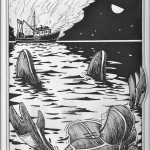
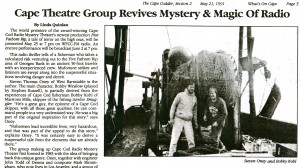
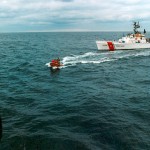
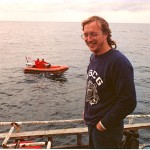
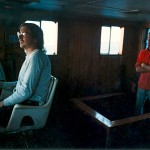
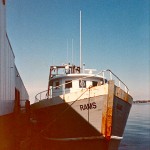
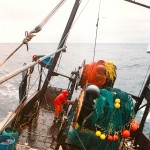
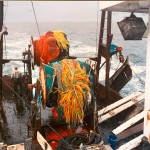

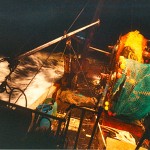
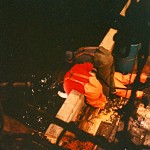
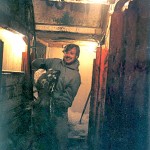
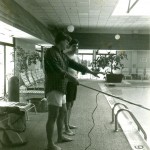
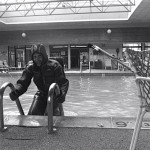
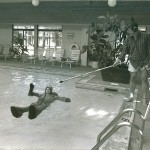

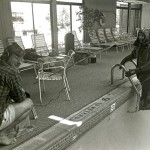
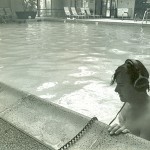
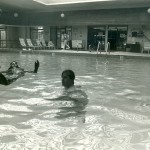
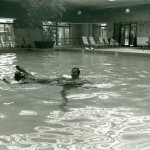
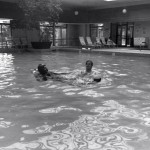
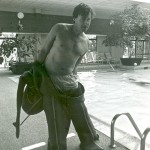
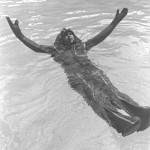
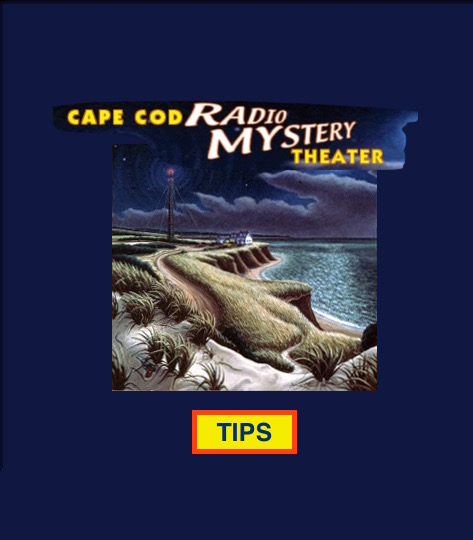

Hello CCRM,
Over the years I have been a big admirer of the work produced by CCRM. There’s hardly a mystery that doesn’t keep my suspense spiked when listening to it.
However, I am puzzled about something pertaining to The Buoy mystery.
As the episode is getting close to its climax, the listener learns that Mr Halpole was actually listening to a story being given by a ghost–Edward Wolcott. We can infer this because Mr Wolcott vanished once the hotel owner showed up to inform Mr Halpole that his room was ready. The puddle on the floor right where Mr Wolcott was supposedly sitting is further indication of a paranormal experience.
What has me unclear is whether the listener is to know if he truly did survive the incident. The story concludes with rescue crews being able to revive Wolcott, as the cold contributed to saving his life. We find out at the beginning of the story that that particular night was the 18th anniversary of the incident, and Wolcott had returned to the abduction site as a test of nerves.
But, once again, we later found out that Mr Halpole was listening to a ghost the whole time.
So did Edward Wolcott truly survive the incident or not? Are we to interpret that he did indeed survive the incident but had died prior to meeting Mr Halpole, and was returning in a ghostly form?
Perhaps I’ve overlooked something in the mystery that would answer my question.
If not or if so, please get back to me either way at your convenience.
Thanks a lot for reading, and have a nice day!
-Andrew Gonda
Dear Andrew,
It is settled lore that New England ghosts often give warnings to humans even though they be locked in deep denial.
Hope this helps!
CCRMT
(Re: background story to Five Fathom Rip)
From the very first recording heard on NPR, the excellent sound effects had such verisimilitude, I was agog and as
tense as if living the story myself. Collecting my own
copies in cassette and then CD, I continued to marvel at the sterling sound story supporting the drama (especially exciting for a West Coaster), and now I find the story behind the story JUST AS EXCITING ! That Mr. Oney really “hangs out” (hangs over? hangs under?) to get this very real aural panorama seems an
act of bravery over and above. Brrrr! My goosebumps
salute you all!
I am listening to Five Fathom Rip for the first time – I have the complete CCRMT series here at my small apartment in Bangkok. Story line, sound effects and all is 100% excellent – the best mystery series since the CBSRMT series that aired 1974 – 1982. Special thanks to Mrs Oney who helped me assemble the collection, with two posters (which are on the walls here on the other side of the world).
(Partial) Spoiler Alert Ahead!
http://articles.orlandosentinel.com/1987-12-03/news/0160330278_1_rector-shrimp-boat-mutiny-and-murder
I hope everyone can link to the article I posted in the link. If the link doesn’t work enter in Google or any search engine “Pair Guilty Of Mutiny And Murder Shrimp Boat Crewmen Face Life Terms In Captain’s Death” + “Orlando Sentinel” I’m almost certain it describes the VERY SAME shrimp boat murder incident that Steve mentions as inspiration in the above liner notes! Please check it out because these two demons definitely pulled some Five Fathom Rip business off the coast of Florida.
Aside from that, 5FR is certainly in my top 3 Steve Oney mysteries. It’s just such a perfect thriller story. You can taste the brine and culture of Cape Cod within much like you can in all of the Cape Cod Mysteries but Five Fathom really nails it. And as stories go in the suspense genre, this one is so scary but so classy. Anyone, like me, who is fed up with the current torture porn out there can always reach for the antidote by pulling Five Fathom Rip off of the shelf. Good for all generations, timeless and holds up, but possibly, and sadly, peerless today.
In parting I wanted to send my love and admiration to the CCRMT folks from further in land (Philadelphia, in fact). And also had a question to Steve, Debbie or whoever could answer it but if I recall correctly it seems Steve Oney indicated he was retiring Underhill and Scofield characters of course and that he had a new one he was working on? Might I guess or suggest that the formidable Peter Millan (spelling?) hopefully be the voice of this new character? He is more of a newcomer compared to the other CCRMT leadingbstars we all love like the amazing Stephen Russell and Neil McGarry just to name two. But Millan has been quite impressive as Helms Kriegle, Ricky Robusto and a couple others. Please Mr. Oney post an exclusive update on the mysterious new character!
Well that’s all for now. See yall next time it rolls in. Also just ordered The Final Case tah day!
Nick in Philly